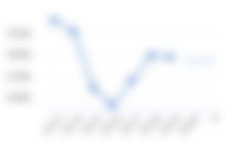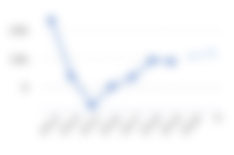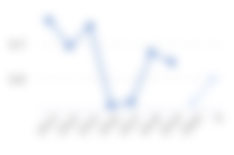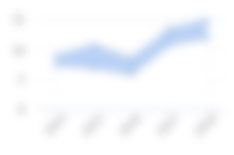INDUSINDBK — Indusind Bank Share Price
- IN₹668.20bn
- IN₹611.48bn
- IN₹267.22bn
- 24
- 57
- 12
- 19
Growth & Value
| 12m Forecast Rolling | Industry | Market | |
|---|---|---|---|
| PE Ratio (f) | 11.97 | ||
| PEG Ratio (f) | 0.28 | ||
| EPS Growth (f) | 73.61% | ||
| Dividend Yield (f) | 1.32% | ||
| Valuation (ttm) | Industry | Market | |
|---|---|---|---|
| Price to Book Value | 1.03 | ||
| Price to Tang. Book | 1.03 | ||
| Price to Free Cashflow | 3.81 | ||
| Price to Sales | 2.5 | ||
| EV to EBITDA | 114.88 | ||
Shareholder Activity
| Type | Buy / Hold / Sell |
|---|---|
| Institutions | |
| Directors | |
| Community |
Guru Screens
Quality
| Name | Industry | Market | |
|---|---|---|---|
| Return on Capital | 0.64% | ||
| Return on Equity | 4.02% | ||
| Operating Margin | 13.19% | ||
Financial Summary
| Year End 31st Mar | Unit | 2021 | 2022 | 2023 | 2024 | 2025 | 2026E | 2027E | CAGR / Avg |
|---|---|---|---|---|---|---|---|---|---|
| Total Revenue | IN₹m | 200,287.73 | 224,084.75 | 257,648.94 | 300,116.9 | 267,217.5 | 300,407.1 | 337,983.34 | 7.05% |
| Operating Profit | m | ||||||||
| Net Profit | m | ||||||||
| EPS Reported | |||||||||
| Diluted Normalised EPS | |||||||||
| EPS Growth | % | -0.76 | +40.14 | +2.8 | +22.1 | -72.61 | +101.91 | +30.15 | n/a |
| PE Ratio | x | ||||||||
| PEG | |||||||||
| Profitability | |||||||||
| Operating Margin | % | ||||||||
| ROA | % | ||||||||
| ROCE | % | ||||||||
| ROE | % | ||||||||
| Cashflow | |||||||||
| Op. Cashflow ps | |||||||||
| Capex ps | |||||||||
| Free Cashflow ps | |||||||||
| Dividends | |||||||||
| Dividend ps | |||||||||
| Dividend Growth | % | ||||||||
| Dividend Yield | % | ||||||||
| Dividend Cover | x | ||||||||
| Balance Sheet | |||||||||
| Cash etc | m | ||||||||
| Working Capital | m | ||||||||
| NFA | m | ||||||||
| Net Debt | m | ||||||||
| Book Value | m | ||||||||
| Diluted Weighted Average Shares | m | ||||||||
| Book Value ps | |||||||||
Other Ratios
| Leverage (ttm) | Total | - Intang | + Pension |
|---|---|---|---|
| Gross Gearing | |||
| Net Gearing | |||
| Cash / Assets |
| Liquidity (ttm) | |
|---|---|
| Curr. Ratio | |
| Quick Ratio | |
| Interest Cov. | |
| Efficiency (ttm) | |
|---|---|
| Asset Turnover | |
| Recs Turnover | |
| Stock Turnover | |
Recent History
| Latest interim period vs. prior period | Industry | Market | |
|---|---|---|---|
| Sales Growth | |||
| EPS Growth | |||
| 3yr Compound Annual Growth Rate | Industry | Market | |
|---|---|---|---|
| Sales CAGR | |||
| EPS CAGR | |||
| DPS CAGR | |||
Profile Summary
IndusInd Bank Limited (the Bank) is engaged in providing financial services. The Bank offers a wide range of products and services for individuals and corporates, including microfinance, personal loans, personal and commercial vehicle loans, credit cards and small to medium enterprise (SME) loans. The Bank's segments include Treasury, Corporate/ Wholesale Banking, Retail Banking, and Other Banking Operation. The Treasury segment includes all investment portfolios, profit/ loss on sale of investments, profit/ loss on foreign exchange transactions, equities, income from derivatives and money market operations. The Corporate/ Wholesale Banking segment includes lending to and deposits from corporate customers and identified earnings and expenses of the segment. The Retail Banking segment includes lending to and deposits from retail customers and identifies earnings and expenses of the segment. The Retail Banking segment is sub-divided into Digital Banking and Other Retail Banking segment.
Directors
- Arun Tiwari NEC (64)
- Sumant Kathpalia CEO (59)
- Arun Khurana DCE
- Gobind Jain CFO
- Shalabh Saxena CEX
- Zubin Mody CHO
- Girish Koliyote CCO
- Ramaswamy Meyyappan CRO
- Rana Anand OTH
- Sanjeev Anand OTH
- Anish Behl OTH
- Ramesh Ganesan OTH
- Sanjay Mallik OTH
- Charu Mathur OTH
- S. Parthasarathy OTH
- Bijayananda Pattanayak OTH
- Anil Rao OTH
- Roopa Satish OTH
- Soumitra Sen OTH
- Rajiv Agarwal NID
- Shanker Annaswamy NID (66)
- Sanjay Asher NID (57)
- Jayant Deshmukh NID (63)
- Bhavna Doshi NID (68)
- Akila Krishnakumar NID (59)
- T. T. Ram Mohan NID (65)
- Last Annual
- March 31st, 2025
- Last Interim
- March 31st, 2025
- Incorporated
- January 31st, 1994
- Public Since
- January 29th, 1998
- Sector
- Banking Services
- Industry
- Financials
- Exchange
National Stock Exchange of India
- Shares in Issue
- 779,055,872

- Address
- 8th Floor, Tower 1, One Indbls Ctr, MUMBAI, 400013
- Web
- https://www.indusind.com
- Phone
- +91 2230493999
- Contact
- Bipin Bihari
- Auditors
- M.P. Chitale & Co
Latest News for INDUSINDBK
Upcoming Events for INDUSINDBK
Q1 2026 Indusind Bank Ltd Earnings Release
Indusind Bank Ltd Annual Shareholders Meeting
Half Year 2026 Indusind Bank Ltd Earnings Release
Similar to INDUSINDBK
Aadhar Housing Finance
National Stock Exchange of India
Aavas Financiers
National Stock Exchange of India
Akiko Global Services
National Stock Exchange of India
Akme Fintrade India
National Stock Exchange of India
Aptus Value Housing Finance India
National Stock Exchange of India
FAQ
As of Today at 21:16 UTC, shares in Indusind Bank are trading at IN₹857.70. This share price information is delayed by 15 minutes.
Shares in Indusind Bank last closed at IN₹857.70 and the price had moved by -42.92% over the past 365 days. In terms of relative price strength the Indusind Bank share price has underperformed the S&P BSE 100 Index by -45.98% over the past year.
The overall consensus recommendation for Indusind Bank is Hold. You can view the full broker recommendation list by unlocking its StockReport.
Find out moreIndusind Bank does not currently pay a dividend.
Indusind Bank does not currently pay a dividend.
Indusind Bank does not currently pay a dividend.
To buy shares in Indusind Bank you'll need a share-dealing account with an online or offline stock broker. Once you have opened your account and transferred funds into it, you'll be able to search and select shares to buy and sell. You can use Stockopedia’s share research software to help you find the the kinds of shares that suit your investment strategy and objectives.
As of the previous close price of IN₹857.70, shares in Indusind Bank had a market capitalisation of IN₹668.20bn.
Here are the trading details for Indusind Bank:
- Country of listing: India
- Exchange: NSI
- Ticker Symbol: INDUSINDBK
Based on an overall assessment of its quality, value and momentum Indusind Bank is currently classified as a Value Trap. The classification is based on a composite score that examines a wide range of fundamental and technical measures. Stock are classified on the the following spectrum: Super Stocks, High Flyers, Contrarians, Turnarounds, Neutral, Value Traps, Momentum Traps, Falling Stars, and Sucker Stocks. For more information, learn about our StockRank Styles.
The analyst consensus target price for shares in Indusind Bank is IN₹789.10. That is 8% below the last closing price of IN₹857.70.
Analysts covering Indusind Bank currently have a consensus Earnings Per Share (EPS) forecast of IN₹66.73 for the next financial year.
Find out moreAn important predictor of whether a stock price will go up is its track record of momentum. Price trends tend to persist, so it's worth looking at them when it comes to a share like Indusind Bank. Over the past six months, its share price has underperformed the S&P BSE 100 Index by -15.9%.
As of the last closing price of IN₹857.70, shares in Indusind Bank were trading -12.8% below their 200 day moving average. You can read more about the power of momentum in assessing share price movements on Stockopedia.
The Indusind Bank PE ratio based on its reported earnings over the past 12 months is 11.97. The shares last closed at IN₹857.70.
The PE ratio (or price-to-earnings ratio) is the one of the most popular valuation measures used by stock market investors. It is calculated by dividing a company's price per share by its earnings per share.
The PE ratio can be seen as being expressed in years, in the sense that it shows the number of years of earnings which would be required to pay back the purchase price, ignoring inflation. So in general terms, the higher the PE, the more expensive the stock is.
Indusind Bank's management team is headed by:
- Arun Tiwari - NEC
- Sumant Kathpalia - CEO
- Arun Khurana - DCE
- Gobind Jain - CFO
- Shalabh Saxena - CEX
- Zubin Mody - CHO
- Girish Koliyote - CCO
- Ramaswamy Meyyappan - CRO
- Rana Anand - OTH
- Sanjeev Anand - OTH
- Anish Behl - OTH
- Ramesh Ganesan - OTH
- Sanjay Mallik - OTH
- Charu Mathur - OTH
- S. Parthasarathy - OTH
- Bijayananda Pattanayak - OTH
- Anil Rao - OTH
- Roopa Satish - OTH
- Soumitra Sen - OTH
- Rajiv Agarwal - NID
- Shanker Annaswamy - NID
- Sanjay Asher - NID
- Jayant Deshmukh - NID
- Bhavna Doshi - NID
- Akila Krishnakumar - NID
- T. T. Ram Mohan - NID





